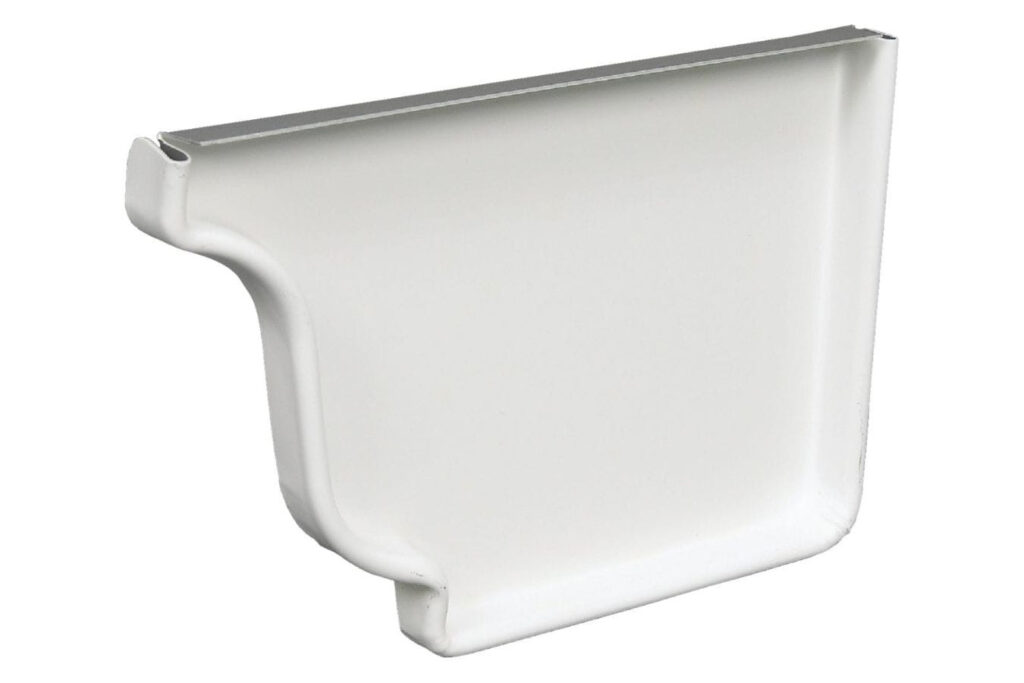When you look up at a house, you might not give much thought to the gutter system. Nevertheless, it plays a big role in defending your home from water damage. Various parts of the gutter system work together smoothly to lead rainwater away from your property efficiently. A single malfunctioning piece can disrupt this harmony and render the entire system ineffective, so let’s delve into the details surrounding rain gutter components so you can have a better understanding of how they work together and what happens when they break.
What Are The Different Parts Of A Gutter System?
A functional gutter system is made up of multiple parts and accessories that each play a unique role in diverting rainfall away from your home. Let’s delve into this anatomy more closely.
1. Gutters Channels
Gutter channels are the main part of the gutter system that you see. They typically come as half-pipe or box-like structures affixed along the edge of your roof. They primarily catch falling precipitation from the roof, protecting your walls and roof from damage by directing it towards a designated drainage area through other gutter components.
2. End Caps

End caps function like sealed ends for gutters, preventing water spillage from non-drainage-designed points. Usually made from aluminum or vinyl, they fit securely at either end of the gutter line.
3. Miters
You can image miters as the corner pieces on your gutter system that connect two linear segments at various angles (typically 90°). Many homes have roofs with sharp angles, so having custom-angled miter joints to allow for the uninterrupted movement of water around corners is crucial.
4. Elbows

Elbows act as connectors between different sections within your overall gutter set-up. Primarily arching at right angles, they help when you need to change direction within your gutter system abruptly, such as channeling accumulated rainfall through downspouts.
5. Gutter Spikes and Ferrules
Gutter spikes are extra-long nails that are driven through the entire gutter system, holding everything in place and securely attaching it to the walls. The included ferrules also prevent gutters from deforming under heavy rainfall or even sustaining damage from a ladder weight. However, this is an old method of hanging gutters and some homes may lack these components.
6. Gutter Hangers

This is the more modern way of attaching a gutter system to your home. They fasten to the eaves while remaining relatively concealed from sight, offering a seamless appearance. They can work alongside spikes and ferrules if necessary to deliver additional structural integrity.
Also Read: Gutter Connectors: The Essential Piece Of Gutter System.
7. Downspouts

Primarily, downspouts serve one purpose: They channel the rainwater collected by gutters to the ground in a controlled manner. Without them, rainwater would simply spill over the edge of your gutters, causing potential damage such as soil erosion and basement flooding. Additionally, these parts for gutters prevent unorganized spillover that can lead to stains on siding around your property.
Downspouts are typically tube-shaped and vertically oriented. They attach to the end part of gutters through an accessory called an elbow – another important component of your gutter accessories.
Anatomy Of A Downspout
These elongated tubes consist of several key gutter pieces specifically designed to manage precipitation effectively:
- Upper Elbow: Located at the top, where it connects directly with gutter sections.
- Lower Elbow: Guides water towards its intended destination, diverting it away from structure foundations.
- Extension: An additional part that ensures water flows a good distance from buildings once expelled from downspout discharge outlets.
The dimensions and materials used for sections might vary depending on specific layouts and preferences, but all these elements play pivotal roles within comprehensive systems related to parts of guttering.
8. Pipe Cleats

These simple metal strips, paired with downspout brackets, secure downspouts onto walls. Without pipe cleats, the stability and functionality of your gutter system will be compromised, and prevent your home from being able to effectively manage rainwater.
9. Splash Blocks

Splash blocks achieve a fairly effortless task, but play an indispensable role within the function of your rain gutter system. They primarily absorb excess water pushed out from the downspouts, reducing soil erosion around the foundations of homes.
10. Rain Chains & Accessories

Rain chains provide aesthetic value while also being utilized as essential gutter accessories while soundly managing rainwater flow. Often employed as visually captivating replacements for standard downspouts, these accessories harmoniously marry form with function within modern residential properties.
Another accessory that isn’t necessary, but can be a good addition to your gutter system, are gutter guards. If you want to protect your gutters from debris, check out our blog post on these 5 gutter guards to get an idea of which one will work best for you.
When viewed individually, these pieces may seem disconnected – but collectively, they play a vital part in ensuring our homes remain dry under whatever weather Mother Nature throws at us! By understanding the importance of these various components in a functional rainwater drainage system, homeowners can maintain their property more effectively and make informed decisions when repairs or replacements are necessary.
Types of Gutters:
Though every gutter system will be made up of similar parts, there are different styles of gutters you can choose from. Each type brings its own unique benefits and may be more suited to certain architectural designs or regional weather conditions than others. Some of the gutter styles you can choose include the following:
- K-Style Gutters
- Half-Round Gutters
- Box Gutters
- Seamless Gutters
How To Measure Gutters To Find The Perfect Size
Measuring gutters accurately is crucial to ensure a perfect fit and optimal functionality for your drainage system.
- Begin by measuring the length of the roofline where the gutters will be installed, taking into account corners and any potential downspout locations.
- Use a measuring tape to record these dimensions in feet and inches.
- Next, measure the width of the roof overhang, accounting for any eaves or fascia that may affect gutter placement.
- Add these measurements together to determine the total length of the gutter channel needed.
- Additionally, measure the height of the fascia board to ensure proper sizing and attachment.
- If your gutter system requires corners or downspouts, measure the distance between them precisely.
It’s advisable to add a few inches to your measurements for a margin of error and to accommodate any unforeseen variations. By taking accurate measurements, you’ll ensure that your gutters fit seamlessly and function effectively, preventing issues such as water overflow and damage to your home’s foundation.
Consult Professional Gutter Installers In Tulsa For Your Gutter Installation
If you are considering installing a new gutter system or repairing a damaged portion, it’s best to consult a professional. At A. Fricker Roofing and Waterproofing in Tulsa, OK, we are committed to delivering exceptional roof and home exterior services, including gutter installation, repair, or replacement. Talk to our expert gutter installers about your gutter and water drainage system by giving us a call today at (918)-402-7167.
FAQs
A. Your gutters play a crucial role in safeguarding the integrity of your home. Neglecting them can lead to potential issues like basement flooding and roof damage. Understanding the rain gutter components involved is key to maintaining a well-functioning system.
A. Recognizing signs of wear and tear is essential. Look out for rust, visible cracks, or sagging gutters. Additionally, if you notice water pooling around your foundation after rain, it might be time to assess and replace specific rain gutter components.
A. Not all gutters are created equal. Different materials offer varying levels of durability and aesthetics. Understanding the pros and cons of materials like aluminum, copper, and vinyl can help you make an informed decision for your home.
A. Generally, cleaning your gutters twice a year is recommended. However, if you have overhanging trees or experience heavy rainfall, more frequent cleaning may be necessary to prevent clogs and maintain proper water flow.
A. Simple components like splash blocks can be DIY projects, but for more intricate tasks involving gutter spikes, miter joints, or downspout installations, it’s advisable to consult a professional to ensure proper alignment and functionality.

